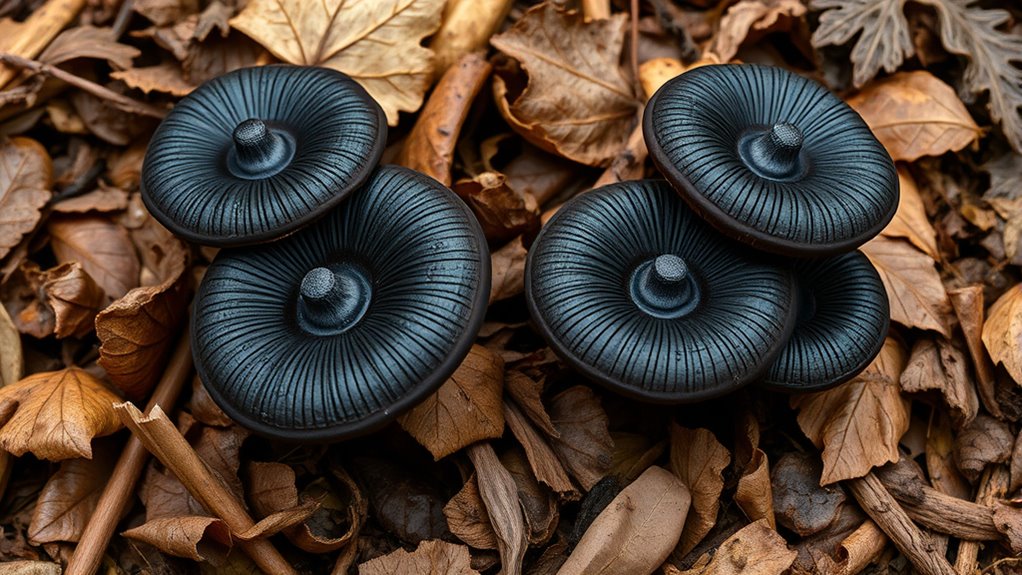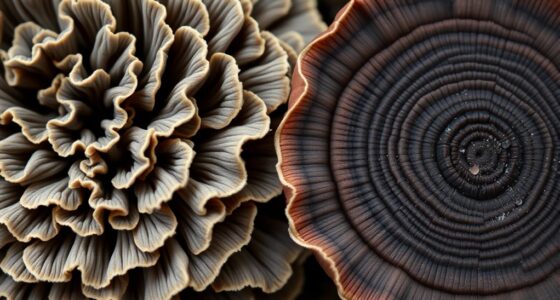To find black trumpets in leaf litter, look beneath moist, shaded forest floors where they grow among decayed organic matter like rotting logs and dense leaves. Move slowly and examine the soil carefully, focusing on dark shapes that blend with the earth but have their characteristic trumpet shape. Gently loosen the mushrooms without damaging their mycelium. If you stay patient, you’ll discover their hidden presence and uncover even more tips.
Key Takeaways
- Search beneath moist, fallen leaves in shaded forest areas where black trumpets thrive.
- Focus on leaf litter around rotting logs, stumps, and dense organic debris.
- Move slowly and examine the litter layer carefully to spot their dark, trumpet-shaped appearance.
- Look for solitary or small clusters of fungi rather than dense groups.
- Use reliable field guides or consult experts to confirm identification before harvesting.

Have you ever discovered black trumpets growing in the wild and wondered about their unique appeal? If so, you’re already on the path to uncovering one of nature’s hidden treasures. These dark, trumpet-shaped fungi often hide beneath leaf litter, waiting for the right moment to reveal themselves. To find them, you need sharp foraging tips that let you spot these elusive mushrooms without disturbing their delicate environment. Look beneath fallen leaves, especially in moist, shaded areas like forest floors or wooded trails. Black trumpets thrive in rich, decayed organic matter, so focus your search around rotting logs, stumps, or dense leaf piles. Get down low and scan carefully; their dark color can blend seamlessly with the earth, but their distinctive shape stands out once you know what to look for.
Discover hidden black trumpets beneath leaf litter in moist, shaded forest areas foraging success
Foraging tips are essential if you want to confidently harvest black trumpets. These fungi are often overlooked because their dark hue can make them difficult to spot. Moving slowly and examining the litter layer thoroughly will increase your chances of success. Remember, black trumpets don’t grow in dense clusters like some mushrooms; instead, you might find a few solitary specimens or small groups. Always double-check your finds against reliable field guides or expert sources before harvesting. Proper identification is vital—mistaking a toxic look-alike can have serious consequences. When you’re confident you’ve found true black trumpets, gently loosen them from the substrate, avoiding damage to the mycelium to guarantee future growth.
Once you’ve gathered these wild delicacies, their culinary uses open a world of flavor possibilities that can liberate your cooking. Black trumpets are prized for their smoky, earthy aroma and rich, meaty texture, making them a versatile addition to many dishes. You can slice and sauté them with garlic and butter, blend them into creamy soups, or dry and grind them into flavorful powders to season your favorite recipes. Their robust flavor pairs beautifully with pasta, risotto, eggs, or even as a topping for pizza. Free yourself from traditional ingredients—black trumpets allow you to craft gourmet meals with a wild, foraged twist. Remember, freshness is key: use them soon after harvesting or dry them for later use. Their unique taste will elevate any dish and remind you of the thrill of foraging and the power of connecting with the wild.
In the end, finding black trumpets in leaf litter isn’t just about collecting fungi—it’s about reclaiming your connection to nature and embracing the joy of foraging. With patience, keen observation, and respect for the environment, you can unlock the culinary potential of these mysterious mushrooms and experience the liberation that comes from sourcing your own ingredients directly from the earth.
Frequently Asked Questions
When Is the Best Time to Harvest Black Trumpets?
You should harvest black trumpets during their prime foraging seasons in late summer to early fall, when they’re most abundant and flavorful. To maximize your bounty, go foraging after a rain, as moist conditions encourage growth. Use harvesting tips like gentle plucking and avoiding damaged mushrooms. Embrace this liberation from store-bought fungi—trust your instincts, learn their habits, and enjoy the thrill of gathering wild black trumpets at their peak.
Can Black Trumpets Be Cultivated Artificially?
You can definitely cultivate black trumpets with the right cultivation techniques, turning mushroom farming into a liberating adventure. While they’re notoriously tricky, innovative growers are experimenting with controlled environments and substrate optimization, making artificial cultivation more feasible. Imagine breaking free from the forest’s grasp and growing these gems at will. With patience and skill, you’ll unseal a world where black trumpets flourish in your own space, no longer bound to leaf litter.
Are Black Trumpets Safe to Eat Raw?
You can eat black trumpets raw, but it’s not recommended as an edible mushroom. Raw consumption may cause stomach upset or allergic reactions, so it’s safer to enjoy them cooked. Cooking enhances flavor and breaks down potential toxins, liberating your taste buds and ensuring safe, delightful experiences. Embrace the freedom of culinary exploration by preparing black trumpets properly, revealing their full potential and savoring their rich, smoky flavor without risking your health.
How Can I Distinguish Black Trumpets From Look-Alikes?
To distinguish black trumpets from look-alikes while leaf litter foraging, focus on mushroom identification details. Black trumpets have a slender, trumpet shape with a smooth, dark, leathery surface and a hollow stem. Avoid mushrooms with gills or a different color. Trust your senses—smell and texture—and when in doubt, consult an expert. Liberation comes from confident, responsible foraging, so always double-check to keep your wild harvest safe and pure.
What Are the Nutritional Benefits of Black Trumpets?
Imagine opening a secret treasure chest—black trumpets are packed with nutrients that fuel your body’s rebellion. Rich in antioxidants, vitamins, and minerals, they boost your immune system and promote overall health. In culinary uses, you can preserve their flavor through drying or freezing, empowering you to enjoy their benefits anytime. By incorporating black trumpets, you take charge of your nourishment, embracing nature’s wild bounty and asserting your culinary freedom.
Conclusion
Now that you know where to find black trumpets in leaf litter, you’ll appreciate how easily they blend into their environment. Did you know that these mushrooms can appear in clusters of up to 20, making them easier to spot once you’re familiar with their habitat? Keep an eye on decomposing leaves and fallen logs, and you’ll increase your chances of discovering these elusive fungi. Happy hunting—your next black trumpet find is just a leaf litter away!









